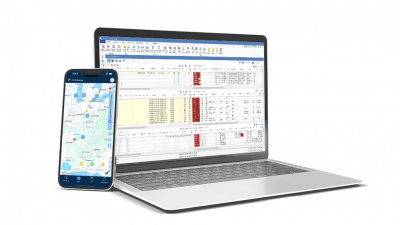Electronic Logging Devices, commonly known as ELDs, are essential for monitoring time and safety in the transportation industry. Commercial vehicle drivers can more easily track their service hours through these digital tools.
But what is an ELD and why are they so important? This article examines ELDs, exploring their features, benefits, and impact on the transportation sector.
What Is an ELD?
An Electronic Logging Device (ELD) is a specialized device that automatically records essential data such as driving time and Hours of Service (HOS). Automating these records is crucial because it replaces old-fashioned paper logs with a digital system that tracks and manages driving hours more accurately and efficiently.
ELDs include a vehicle tracking device, fleet management software, and a mobile app. Mandated by MAP-21, the ELD rule aims to create a safer work environment for drivers by making tracking, managing, and sharing Records of Duty Status (RODS) data more efficient and accurate. By synchronizing with the vehicle’s engine, ELDs automatically record driving time, ensuring precise HOS recording.
Key Features and Functions of ELDs
ELDs provide fleet managers and drivers with crucial features, streamlining fleet management and enhancing safety. This section will explore the essential features of ELDs that benefit both drivers and fleet managers in commercial transportation.
Real-Time Tracking and Monitoring
One of the standout features of the ELD is the capability for real-time fleet tracking and monitoring. This function is a game-changer for fleet managers, allowing them to access up-to-the-minute data on driver activities. Using this information, they can optimize routes, plan schedules more efficiently, and comply with hours-of-service regulations. Real-time insight into fleet operations improves efficiency, safety, and regulatory compliance.
Automated Log Entries
ELDs can automate log entries, representing a significant shift from traditional manual logbooks. According to the Federal Motor Carrier Safety Administration (FMCSA), using ELDs reduces drivers’ time on logbooks and saves $53.68 million annually in recordkeeping costs.
What’s more, automating these time-consuming tasks frees up fleet managers to concentrate on more critical aspects of their operations. This streamlines record-keeping and enhances overall operational efficiency.
Data Storage and Accessibility
ELDs efficiently store a wealth of driving data, such as HOS records, vehicle movement, and mileage. Data is secure and easily accessible to fleet managers and drivers, ensuring information is readily available for review, analysis, or compliance checks. The accessibility of this data facilitates prompt decision-making and efficient fleet operations management.
Safety and Diagnostic Reporting
ELDs contribute to road safety by monitoring driver behavior and service hours. These devices ensure drivers don’t operate vehicles while fatigued, promoting safer driving conditions and reducing fatigue-related accidents. Their behavior monitoring features offer insights into driving patterns, enabling fleet managers to cultivate a safe driving culture. This not only safeguards drivers but also enhances truck fleet management and efficiency.
Additionally, ELDs simplify regulatory compliance and inspections by ensuring accurate, tamper-proof records in adherence to transportation regulations.
The ELD Mandate: Understanding the Legal Framework
The ELD Mandate, or ELD Final Rule, is a US regulation requiring commercial motor vehicle operators to use ELDs. Enforced by the FMCSA since December 2017, the mandate aims to improve road safety and manage driver hours more effectively.
ELDs record vehicle operation and driver HOS — a record of driving, on-duty non-driving hours, and rest periods. This shift from paper logs and earlier Automatic On-Board Recording Devices (AOBRDs) to ELDs ensures more accurate and reliable data, reducing the risk of falsified records.
The mandate, crucial for the trucking industry, helps prevent fatigue-related accidents and simplifies compliance with HOS regulations. It levels the playing field for all drivers, promoting uniform safety standards across the industry.
Compliance Requirements for ELDs
Navigating the compliance requirements for ELDs is vital for anyone in the trucking industry. These regulations aren’t just guidelines but mandatory rules that ensure safety and fairness in the industry. Here’s an overview of the critical compliance requirements for ELDs.
Driver Requirements
Compliance with ELD requirements and overall safety necessitate the following for drivers:
- Hours of Service Records: Accurate recording of HOS is mandatory to ensure adherence to prescribed driving limits and rest requirements.
- FMCSA Rules Knowledge: Drivers must receive adequate training in FMCSA rules. Maintaining documentation of driver training and compliance is crucial.
- Qualification and Safety Records: Maintain comprehensive qualification records for all drivers, including a commercial driver’s license (CDL), medical examiner’s certificate, and records of traffic violations, to ensure safe and legal operation standards.
- Regular Drug and Alcohol Testing: Conduct random drug and alcohol tests following DOT regulations to ensure driver safety.
- Pre-Employment Drug Testing: Document and maintain records of pre-employment drug testing for each driver, including any history of drug and alcohol abuse.
Fleet Requirements
Maintaining compliance for fleets involves adhering to the following:
- Vehicle Inspections: Conduct and document mandatory pre-trip and post-trip vehicle inspections. Promptly address and repair any identified defects.
- Maintenance Program: Implement a robust vehicle maintenance program and maintain detailed records for compliance.
- FMCSA Rules: Ensure an up-to-date copy of the FMCSA rules is available in the office for reference, aligning operations with current regulations.
- DOT Registration Number: All fleet vehicles must display a DOT registration number for identification and regulatory compliance.
- Incident Records: Maintain detailed records of road incidents involving fleet vehicles to monitor safety standards and respond to compliance queries effectively.
Getting all the data and insights you need from your ELD provider?
Bring your tech stack together and learn how to achieve exceptional insights with PCS TMS.
Comparing ELDs and AOBRDs
The shift from AOBRDs to ELDs represents a significant upgrade in the trucking industry. ELDs must meet stringent technical standards set by the FMCSA, which maintains an official ELD list of registered devices self-certified by providers compliant with the ELD rule.
Electronic data transmission is a key advancement of ELDs, enabling real-time monitoring and simplified inspections. The ELD rule requires drivers and carriers to use ELDs or grandfathered AOBRDs since 2017. Understanding this difference is crucial for compliance, as ELDs ensure greater accuracy and efficiency in hours of service monitoring.
The Cost of Implementing ELDs
Implementing ELDs incurs varying costs, typically ranging from a few hundred to several thousand dollars per vehicle. These expenses include the hardware of the device, potential professional installation fees, and monthly software subscription fees. It’s crucial for carriers to diligently research and compare ELD providers to ensure they receive good value for their investments.
Ongoing expenses differ based on the device type and features. The FMCSA estimates the yearly cost for ELDs using cellular data transfer at about $419, while those using Bluetooth or USB 2.0 are around $166 annually.
Despite the initial and ongoing expenses, investing in ELDs can yield significant returns. These benefits include enhanced fleet productivity, fuel efficiency, safety, and regulation compliance.
The Benefits of ELDs for Businesses
ELDs offer many benefits for carriers, significantly impacting safety, efficiency, and compliance. Trucking companies can ensure safer and more efficient operations by integrating these devices into fleet management.
- Improved Safety: By enforcing compliance with HOS regulations, ELDs reduce driver fatigue and the risk of fatigue-related accidents. The American Trucking Association (ATA) found a 53% reduction in driving-related violations among trucks with ELDs, demonstrating a clear safety improvement.
- Efficiency in Record-Keeping: ELDs eliminate the need for paper logbooks, leading to more accurate record-keeping and reduced administrative burden.
- Quicker Roadside Inspections: ELDs streamline the inspection process, allowing drivers to spend less time during roadside checks and more time driving.
- Fleet Efficiency: Beyond compliance, ELDs offer insights for reducing fuel costs, monitoring engine idling, and improving route planning. Digital maintenance tools also help increase vehicle uptime, improving fleet efficiency.
- Access to Real-time Data: Real-time data access allows for proactive decision-making and increased fleet productivity.
ELD Compliance: Issues and Solutions
Trucking companies must address compliance challenges to ensure smooth operations. Here’s a look at a few common problems and practical solutions related to ELD compliance.
Technical Challenges and Troubleshooting
Addressing technical challenges associated with ELDs is essential for maintaining compliance. These challenges can include hardware malfunctions and software glitches. Regular maintenance and timely updates are key strategies in preventing such technical issues.
Training drivers and staff in using ELDs and basic troubleshooting is equally important. The FMCSA provides a complimentary checklist to aid in this training process.
Access to reliable technical support from ELD providers is crucial for swiftly resolving more complex issues. In cases of device failure, having backup systems, such as traditional logbooks, can act as a temporary solution. Regular preventative checks are vital to early identification and resolution of potential problems, ensuring the ELD systems remain operational and compliant.
Data Privacy and Security Concerns
Data privacy and security are essential for ELDs as they handle sensitive driver information. Implementing strong cybersecurity measures is vital to protect data, addressing secure data transmission, storage encryption, and defenses against unauthorized access.
Regularly updating security protocols and conducting audits are essential to identify and mitigate vulnerabilities. Additionally, educating staff on best data security practices with ELDs and trucking apps is crucial in minimizing human error risks.
Managing Compliance Across State Lines
Navigating ELD compliance becomes more complex for operations that cross state lines, given the variations in regulations. Staying informed about different state HOS regulations is essential. Engaging with industry associations and continuously monitoring regulatory updates can provide critical information.
It’s also important to train drivers on each state’s specific regulations. Using advanced ELD systems that automatically adjust to varying state regulations can significantly simplify compliance. Centralizing compliance management within an organization can streamline the tracking and maintenance of these regulations.
Addressing Driver Resistance and Training
Drivers often resist ELDs due to misunderstandings about how they work. To address these concerns, clearly communicate the benefits of ELDs, such as enhanced safety and simpler record-keeping. It’s also important to train drivers on ELDs so they’re aware of their features and benefits and comfortable and competent using them.
Fostering a supportive environment where drivers can express their concerns and seek assistance with ELD-related issues is key to encouraging acceptance. Actively involving drivers in selecting and implementing ELDs can reduce resistance, giving them a sense of ownership and control over the changes affecting their work.
Maximize ELD Efficiency with PCS TMS
Electronic Logging Devices (ELDs) enhance safety, compliance, and operational efficiency in contemporary fleet management. Features like real-time tracking, automated logging, and secure data storage significantly improve safety and compliance protocols.
Integrating ELDs with a transportation management system like PCS TMS amplifies these benefits, optimizing operations and compliance monitoring. This integration combines the robust capabilities of a TMS with the precision of ELDs and the versatility of mobile solutions. It automates compliance processes, streamlines communication with drivers, and delivers comprehensive analytics, elevating safety, compliance, and efficiency in fleet management.
For more details or to discover how integrating your current ELD with PCS TMS can help your operations, schedule a demo today.



